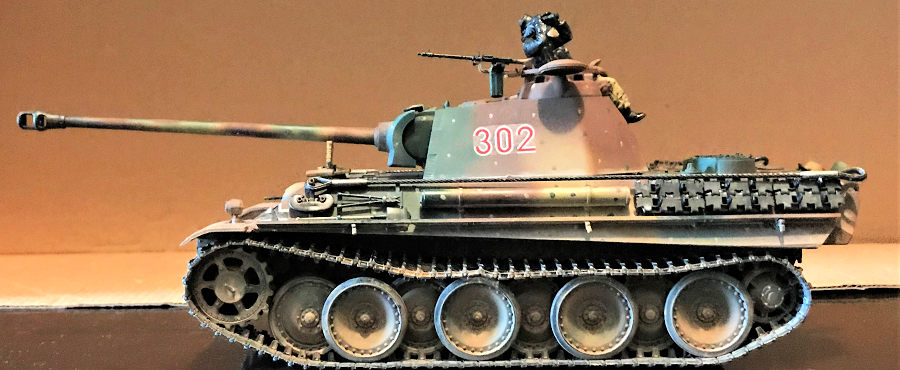
| KIT #: | 35163 |
| PRICE: | $45.00 |
| DECALS: | Three options |
| REVIEWER: | Donald Zhou |
| NOTES: | Advantages: Nicely detailed, easy assembly, accurate. Disadvantages: some small parts missing. No dust screens for the air intakes. |

| HISTORY |
When WW II started with the German invasion of Poland in 1939, the Wehrmacht force shocked the world with their Blitzkrieg tactics (the word was actually invented by the British believe it or not) of using tanks, or panzers as a shock force to drive a wedge into the defenders, then the following infantry would mop up the remaining survivors. Believe it or not, at the time, the Panzerwaffe was actually not well equipped to really Do this….It’s surprising, but the majority of Wehrmacht armed forces were still horse drawn, especially to the bitter end when fuel became chronically short (the fact of the matter is, it’s the U.S. Army that became the world’s first true mechanized army, thanks in no small part to the “Arsenal of Democracy”……And that is in thanks to companies like…..As “Web” in Band of Brothers so eloquently screamed, “Say hello to Ford and General Motors!!!” These companies, along with Studebaker etc produced trucks and other vehicles in such numbers that they not only equipped the U.S. Army, but also were given to the British, the Free French Army, and Russia to the tune that many Russian drivers simply abandoned broken vehicles, knowing full well there was another American made truck waiting for them later!). The fact that it was very successful was simply the Allies at the time didn’t have anything to defend against this tactic! The sight of Polish cavalry on horsebacks charging against steel is something of a tearjerker but also brutally shown how warfare has forever changed. Even as the Panzer force came up against superior French tanks such as the Suma and the Char B, superior tactics, momentum and general Allied ineptitude kept the Germans going. All of that, however, was about to come to a crash halt!
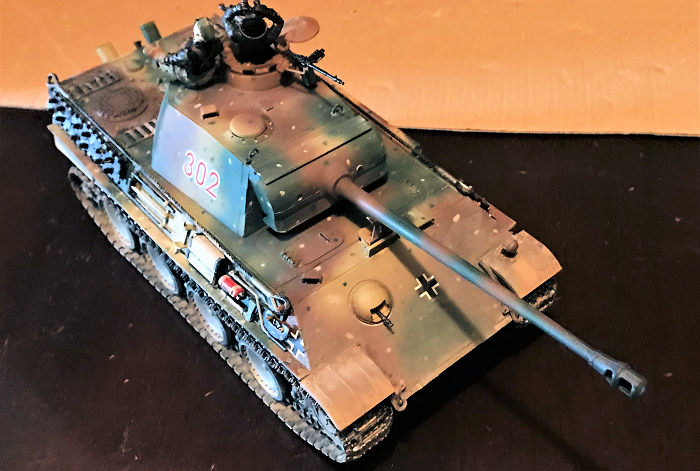 At the start of Operation Barbarossa, the Germans
quickly swept all opposition aside. Then the Wehrmacht came up against the
excellent T-34 and the shellshock was supreme! Simply put, the T-34 was better
than all of the German Panzers up to that point. The mainstay of the Wehrmacht
Panzerwaffe was the Panzer III, used against other tanks with a 50mm gun. This
quickly proved very inadequate against the T-34, with its thick angled hide and
excellent 76mm main armament, the T-34 can stand well off and fire against the
Panzer III with impunity. The other was the Panzer IV. Armed with a short
barreled 75mm gun, The Panzer IV mark D was mainly used to tackle fortifications
and pill boxes, not really well suited against other tanks. The problem became
compounded when the heavier KV-1 showed up, and then there was the monstrous
KV-2, one of which blocked the advance and received over 100 hits before the
legendary 88mm was able to knock it out! Obviously, an answer was needed to be
found against these new Russian tanks.
At the start of Operation Barbarossa, the Germans
quickly swept all opposition aside. Then the Wehrmacht came up against the
excellent T-34 and the shellshock was supreme! Simply put, the T-34 was better
than all of the German Panzers up to that point. The mainstay of the Wehrmacht
Panzerwaffe was the Panzer III, used against other tanks with a 50mm gun. This
quickly proved very inadequate against the T-34, with its thick angled hide and
excellent 76mm main armament, the T-34 can stand well off and fire against the
Panzer III with impunity. The other was the Panzer IV. Armed with a short
barreled 75mm gun, The Panzer IV mark D was mainly used to tackle fortifications
and pill boxes, not really well suited against other tanks. The problem became
compounded when the heavier KV-1 showed up, and then there was the monstrous
KV-2, one of which blocked the advance and received over 100 hits before the
legendary 88mm was able to knock it out! Obviously, an answer was needed to be
found against these new Russian tanks.
The first few solutions was to quickly adapt a long barreled 75mm and quickly inserted into the Panzer IV since the Panzer III were too small to adapt this weapon. This finally allowed the Wehrmacht to fight the T-34 on equal footing. However, what the Wehrmacht really wanted was something completely superior to the T-34. This was the Panther and in some respects, the Tiger.
The VK20 project was actually started back as early as 1938, as a replacement for the Panzer III and IV. However, as the war progressed heavily in favor of the Germans the project was slowed to a crawl. All of that went out the window immediately upon the encounters with the T-34 and the KV-1. A new project, code named VK30.02 were headed by both Daimler-Benz and MAN to design a replacement with a 30 ton weight. Lessons learned from captured T-34 examples will be built into the new design. These include a sloped frontal armor, which proved effective at deflecting incoming rounds, and thus against penetration, wide tracks to move over rough and soft grounds, especially in Russia and finally, a well-armed gun to stand off against enemy armor.
The DB design was nearly a complete copy of the T-34, featuring well sloped armor, a diesel engine with a rear drive and the turret near the front. The MAN’s offer is more conventional, with a Maybach gasoline engine, transmission at the front and turret in the center. The tank would also features interleaved road wheels very much like the Tiger with torsion bar suspension and would feature a long 75mm gun that’s actually superior to the Tiger’s famed 88. Although Reich production minister Albert Speer and Heinz Gudarian preferred the DB version, it was Adolf Hitler that made the decision to go with the MAN’s version instead. The final design weight ballooned to 45 tons and more due to the demand made by Hitler to increase the frontal armor to 80mm total. Due to the slope and the quality, the equivalent was actually 150mm on the turret front and up to 110mm for the glacis! This proved to be nearly impervious to any Allied tank gun except the 122mm in the JS-2, the 76mm in the Sherman Firefly, and the 90mm in the M36 Jackson and M26 Pershing. However, to keep the ballooning weight down, the side armor and especially the rear was kept at bare minimum. The side armor was actually so thin, 45-55mm depending on the version, that even a 75mm armed Sherman could defeat the Panther from the side at standard combat ranges. This made sure that all Panther commander were made well aware to defend their flanks. The tank would be powered by a Maybach engine developing initially 650HP, later upgraded to 700. This gave the tank good power to weight ration compared to the Tiger, which used the same engine but suffered from mobility problem to its massive 55 ton weight.
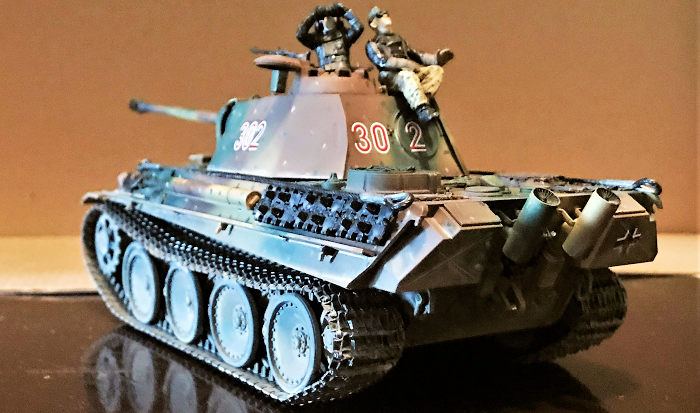 The tanks main armament is a Rheinmetal Borsig 75mm
KWK-42 L70 weapon. Due to the ammunition in having much more powder than
competing 75mm shells, and a very long barrel, the gun have more penetrating
power than even the Tiger 88. This also made aiming easier since the initial
muzzle velocity is so high, the trajectory is extremely flat. The tank was
further armed with two MG34 machine guns, one co-axle with the cannon, the other
in the hull at the bow. The initial D and very early A version had a slit in the
hull to fire the bow machine gun. This was later updated in the Mid A version to
a bow ball mounted version. Overall, the Panther was one of the best tanks to
see production, offering one of the best compromises in its armor, armament, and
power.
The tanks main armament is a Rheinmetal Borsig 75mm
KWK-42 L70 weapon. Due to the ammunition in having much more powder than
competing 75mm shells, and a very long barrel, the gun have more penetrating
power than even the Tiger 88. This also made aiming easier since the initial
muzzle velocity is so high, the trajectory is extremely flat. The tank was
further armed with two MG34 machine guns, one co-axle with the cannon, the other
in the hull at the bow. The initial D and very early A version had a slit in the
hull to fire the bow machine gun. This was later updated in the Mid A version to
a bow ball mounted version. Overall, the Panther was one of the best tanks to
see production, offering one of the best compromises in its armor, armament, and
power.
As soon as the design was finalized, the new tank was thrown into the fray. Production were hurriedly sped up in order to allow the new tank, along with the Tiger to participate in Operation Zitadel, the Battle of the Kursk, where the new tank failed spectacularly! This was due in no small amount to the fact that the design was simply too rushed! Over 80% of the tank suffered from one reliability and mechanical fault after the other. In fact, maintenance and reliability issues dogged the tank from beginning to end. After the initial battle, several improvements were quickly made to the D version. These include the aforementioned changes to the bow machine gun position. The commander cupola was also changed and mantlet thickened. The new version, the Panther A was the most produced since a host of improvement were made to its engines and transmission that solved many of the problems plaguing the initial version. However, some were never be able to solve. The transmission problems still lingered and this plagued the tank till the very end.
The final version is the G. The most obvious change was the vision slit on the driver side was eliminated to prevent the apparent weak point from taken advantage off. The driver was given a rotatable periscope. Other changes included both the driver and radio operator hatch are now designed to swing upwards quickly to facilitate escape. The side sponsons are less sloped to be in line with the turret. This opened more spaces to allow the G version to carry more ammo. Because of this, side armor was thickened a little to an equivalent of 55mm. From the Mid production G onward, a mantlet with a much thicker lower lip was added. This solved one of the Panther’s biggest weakness. The rounded mantlet, the downward rounding lip proved to be a decidedly good shot trap where it bounced rounds right through the very thin hull roof or right into the turret ring….Both equal the tank being taken out of the action. The thick, straight lower lip mantlet solved this problem. Overall, many historians gave the Panther as the best tank of WW II, even better than the Tiger since it’s far more mobile, reliable and its firepower is actually stronger and offers the same protection, at least frontally. Over 5000 Panthers were produced, second only to the Panzer IV in terms of production.
| THE KIT |
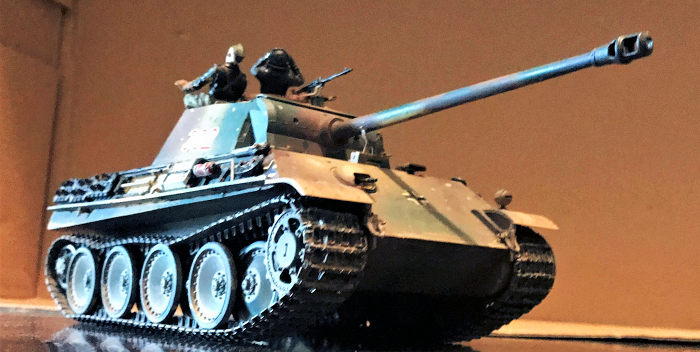 Yeah, I mainly got this kit to compensate for my Takom
kit with the interior, what with over 1000 parts and numerous small parts to
boot! Now, again, like a series of Tamiya kits, this my second run through with
this kit since I built the first one when it first came out in 2003-2004 and
then had to give it up when I moved to China long term. After sighing and
putting my Takom Panther up on the shelf of…Not exactly shelf of doom but more
like the shelf of “WTF ARE YOU THINKING MIND FARTING FIASCO OF A PURCHASE”
place, I decided to go at another run at this kit.
Yeah, I mainly got this kit to compensate for my Takom
kit with the interior, what with over 1000 parts and numerous small parts to
boot! Now, again, like a series of Tamiya kits, this my second run through with
this kit since I built the first one when it first came out in 2003-2004 and
then had to give it up when I moved to China long term. After sighing and
putting my Takom Panther up on the shelf of…Not exactly shelf of doom but more
like the shelf of “WTF ARE YOU THINKING MIND FARTING FIASCO OF A PURCHASE”
place, I decided to go at another run at this kit.
Again, this kit first came out in the early 2000’s and is at the forefront of the third generation of Tamiya kits that offer more details than the second generation, plugged up the holes on the bottom and usually contains a figure or two, in this case, based on a famous photo of a commander and a loader scanning the skies near Normandy before the June 6th landings for “Jabos”…At that time, the Luftwaffe had long ago conceded air superiority, and eventually supremacy to the Allies and the Panzerwaffe was constantly had to put on alert for menacing Allied fighter-bombers such as the P-47 Thunderbolt (speaking of, sigh, gonna have to complete my Trumpeter 1/32 version soon enough….The thrice dammed NMF finish!!!!) and the Hawker Typhoon, Jadgtbomber or Jabos for short. Overall, it was an easy and painless kit, just took me awhile since I hopped between all sorts of projects and then I discovered the E2046 web site and started to pour money on THAT too!!!!!! This is the correct late version since it has the mantlet with the thick lower lips that prevents enemy rounds from bouncing downwards into the upper hull.
| CONSTRUCTION |
Again, painless…Well, except the road wheels. Like all German “KitieKats” tanks, the road wheels are interleaved. The first thing to notice are all the road wheel arms. One set points to the front of the tank, the other to the rear! Again, the only two tanks I know of are the Tigers and Panthers that does this while all the rest have the rest point to the rear only! Caused me and I’m sure others quite the confusion when they first made a panther or tiger!
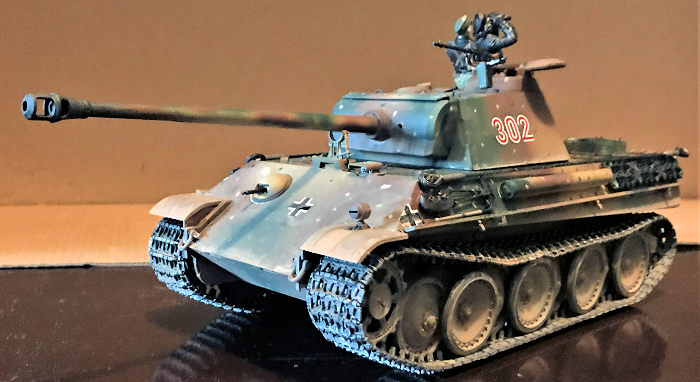 Then comes the road wheels themselves. Make sure you
read the instructions carefully. It’s not as confusing as the Tiger initial
through mid-production versions but it’s confusing enough. First, the inner most
road wheels for the even number arms, 2, 4, 6, 8 are put in first, now the odd
number wheels, 1, 3, 5, 7, the sandwiched together wheels to form a single wheel
type are put in next before the outer most even number wheels are put in. Again,
follow the instructions closely if you are confused. The Germans later adapted
this setup for the late version of the Tiger with the steel road wheels but it’s
still a mess mash of a jumble when it’s done! The rest are assembled quickly as
there are not much parts. Just be sure to use the late production exhaust pipes
instead. If you are judicious with the glue, the rear round turret hatch can be
made to move. Now, periscopes are provided for the driver, co-driver and the
gunner but the seven periscopes for the commander are not. Also, the periscopes
are solid casting, no clear parts are in the kit. I was able to get the driver
and gunner periscope in cause I cemented the hatches on and was able to break
off the driver’s one but not the co-driver so there is that. Since this kit did
not have the dust screens, I used the nylon stockings provided with one of my
figure kits as a substitute. It works but while applying a bit of heat to burn
off the excess on one panel, it screwed the panel up! I painted that as if there
was an accident (common with the Panther) or it got hit in this area. Anyways,
time for some paint so to the paint shop time!
Then comes the road wheels themselves. Make sure you
read the instructions carefully. It’s not as confusing as the Tiger initial
through mid-production versions but it’s confusing enough. First, the inner most
road wheels for the even number arms, 2, 4, 6, 8 are put in first, now the odd
number wheels, 1, 3, 5, 7, the sandwiched together wheels to form a single wheel
type are put in next before the outer most even number wheels are put in. Again,
follow the instructions closely if you are confused. The Germans later adapted
this setup for the late version of the Tiger with the steel road wheels but it’s
still a mess mash of a jumble when it’s done! The rest are assembled quickly as
there are not much parts. Just be sure to use the late production exhaust pipes
instead. If you are judicious with the glue, the rear round turret hatch can be
made to move. Now, periscopes are provided for the driver, co-driver and the
gunner but the seven periscopes for the commander are not. Also, the periscopes
are solid casting, no clear parts are in the kit. I was able to get the driver
and gunner periscope in cause I cemented the hatches on and was able to break
off the driver’s one but not the co-driver so there is that. Since this kit did
not have the dust screens, I used the nylon stockings provided with one of my
figure kits as a substitute. It works but while applying a bit of heat to burn
off the excess on one panel, it screwed the panel up! I painted that as if there
was an accident (common with the Panther) or it got hit in this area. Anyways,
time for some paint so to the paint shop time!
| COLORS & MARKINGS |
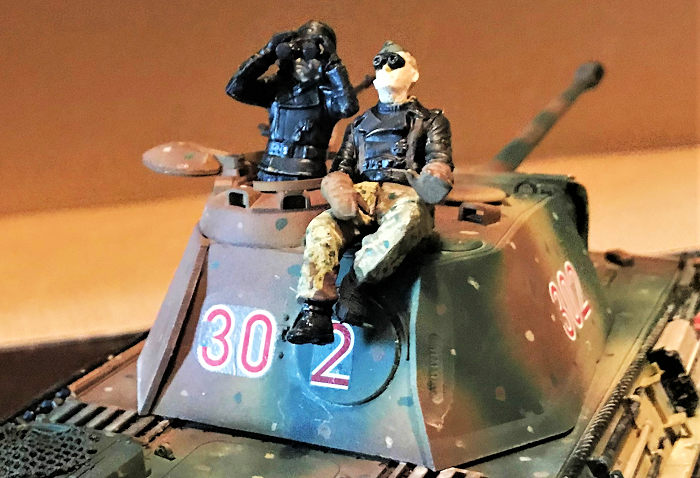 I chose red 302 since the markings are brighter and
breaks up the overall rather dark three tone camo that most German tanks carried
near the Normandy campaign. The markings are very generics since the real tanks
at the correct point in time were also very generic, with no unit markings or
call out so Allied intelligence can’t tell what is what. I also elected to do
the German “ambush” pattern with all the dots on the camo pattern. The paints
are all Tamiya, which is what I prefer when doing the German three tone, Dark
Yellow, Dark Green (2) and Red Brown. These were sprayed freely cause again,
there isn’t a set pattern for the German three tone since the crews painted them
every which way as they saw fit. Afterwards, taking a thin brush, I applied
yellow dots to the green and brown parts, brown to the green and yellow parts,
and green to the brown and yellow parts. Since I’ll be depicting a well-used
tank, I dirtied up the bottom and dusted the rest.
I chose red 302 since the markings are brighter and
breaks up the overall rather dark three tone camo that most German tanks carried
near the Normandy campaign. The markings are very generics since the real tanks
at the correct point in time were also very generic, with no unit markings or
call out so Allied intelligence can’t tell what is what. I also elected to do
the German “ambush” pattern with all the dots on the camo pattern. The paints
are all Tamiya, which is what I prefer when doing the German three tone, Dark
Yellow, Dark Green (2) and Red Brown. These were sprayed freely cause again,
there isn’t a set pattern for the German three tone since the crews painted them
every which way as they saw fit. Afterwards, taking a thin brush, I applied
yellow dots to the green and brown parts, brown to the green and yellow parts,
and green to the brown and yellow parts. Since I’ll be depicting a well-used
tank, I dirtied up the bottom and dusted the rest.
| FINAL CONSTRUCTION |
The main thing are all the pioneer tools. After he tracks are put on, these are rubber bands type so I had to super glue the top rung on the road wheels since the real thing sagged pretty heavily on top of the road wheels and then weathered them also with dusty and mud paints before applying a bit of gun metal and metallic grey to the treads to symbolize these areas were grounded to a shine.
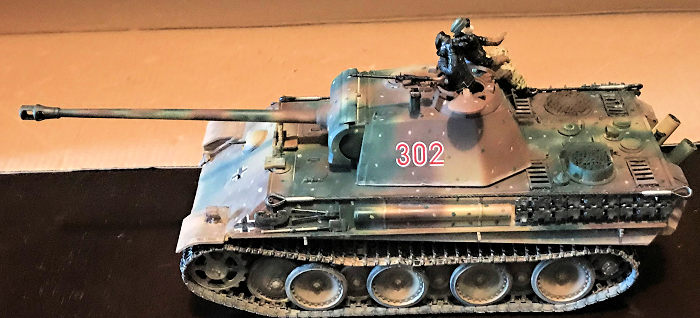 Next are all the tools. Panthers had specific
placement racks for all the tools. These were painted with wood handles for the
shovels and axes, red fire extinguisher, gun metal for the shovel, ax, the 40
ton jack and the tow cable strengtheners and gunmetal with metallic grey were
used for the tow cables. It is here that a few details are missing. The end
cable containers were missing on the kit so if that bothers you, you can create
on your own. The last thing to go on is the MG-34 for the commander. As the
Luftwaffe slowly started to lose the control of the sky over Europe, the Panzer
corp. crews were given a third MG-34 to mount on the cupola as an aerial defense
weapon but the crew also liked it cause it can be used against infantry. Next
are the spare tracks. Come to think of it, need to take it downstairs to rust
them up. Again, and again, and again, and again…Real operational tracks do not
rust due to the fact the grinding with each other and against the ground will
slough off the rust. However, leave the spares on too long, especially WW II
tracks, they will rust very quickly, especially under wet conditions like the
days just before the landings.
Next are all the tools. Panthers had specific
placement racks for all the tools. These were painted with wood handles for the
shovels and axes, red fire extinguisher, gun metal for the shovel, ax, the 40
ton jack and the tow cable strengtheners and gunmetal with metallic grey were
used for the tow cables. It is here that a few details are missing. The end
cable containers were missing on the kit so if that bothers you, you can create
on your own. The last thing to go on is the MG-34 for the commander. As the
Luftwaffe slowly started to lose the control of the sky over Europe, the Panzer
corp. crews were given a third MG-34 to mount on the cupola as an aerial defense
weapon but the crew also liked it cause it can be used against infantry. Next
are the spare tracks. Come to think of it, need to take it downstairs to rust
them up. Again, and again, and again, and again…Real operational tracks do not
rust due to the fact the grinding with each other and against the ground will
slough off the rust. However, leave the spares on too long, especially WW II
tracks, they will rust very quickly, especially under wet conditions like the
days just before the landings.
Finally, the crews were painted in their relevant colors and put in their spots to give some personality to the tank.
| CONCLUSIONS |
Simply put, eventually…EVENTUALLY I WILL finish my Takom Early/Mid Panther as a late Panther A instead. However, until then, this kit more than holds up. Yeah, yeah, yeah, it does not have all the bells, whistles and bang bangs like the Dragon, Takom or RFM kit but then again, the reason why my Takom kit is still in the box is because it has over 2000 parts and I do not feel the urge to deal with that now. But anyways, if you can source some dust screen, this kit can still be built to modern standards easily with a very reasonable price indeed!
4 January 2022
Copyright ModelingMadness.com. All rights reserved. No reproduction in part or in whole without express permission.
If you would like your product reviewed fairly and fairly quickly, please contact the editor or see other details in the Note to Contributors.